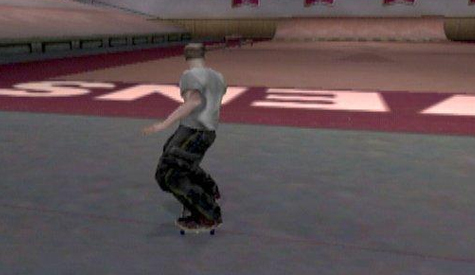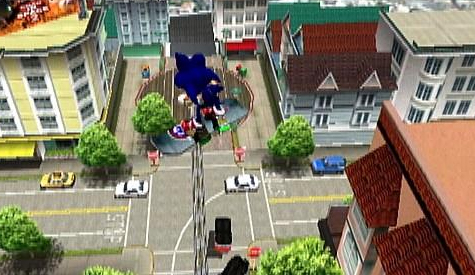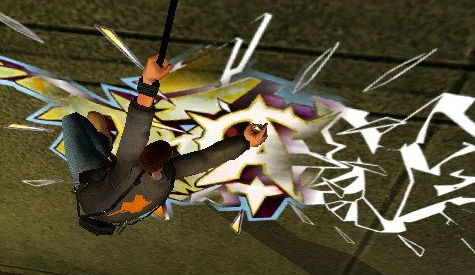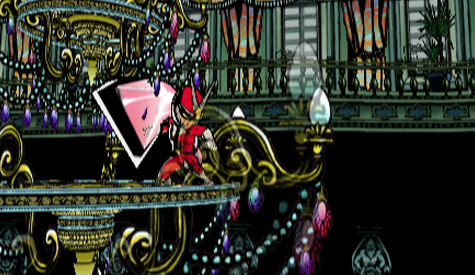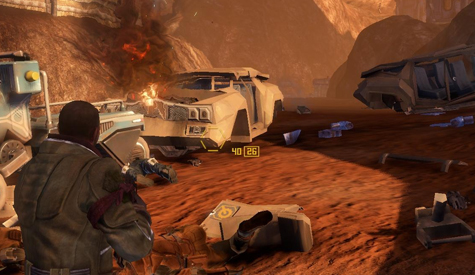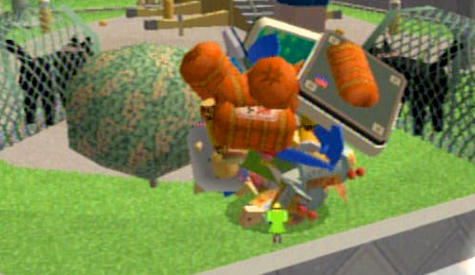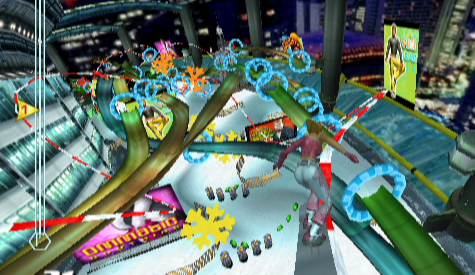Jet Set Radio’s been on our minds a lot here at Sega Addicts Headquarters. There’s the HD re-release coming soon, our current contest to win a JSR hoodie and our own Josh Newey has even started his own Neo-Tokyo street gang recently. With all these JSR thoughts going through our heads we decided to put the knowledge to good use. It’s been a long time since any new game has come out in the much-loved series and there has to be fans out there looking to play something that has some of that JSR feeling. We’ve attempted to create a list of 10 games that mimic some aspect of the series whether it’s in gameplay, visuals, tone, etc.
Hit the jump to read our list of 10 games with similarities to Jet Set Radio!
Tony Hawk Series
Flake: Okay, this is a gimme. No doubt about it, this is the obvious comparison. Both games are about people moving about on wheels while doing stunts. Also, music.
But here’s the thing: A LOT of skateboarding games have been made and they are not on this list. The early Tony Hawk games (i.e. the ones that did not suck) were about more than just snapping digital ankles doing impossible stunts in unlikely places to songs from band that are no longer relevant. They were about attitude. There was a definite ‘stick it to the man’ vibe but it was tempered by a dry humor. It was the kind of game that could only be made by the 90’s, in the 90’s, for and audience of the 90’s. Jet Set Radio’s story and style felt like a bit of a carry over from the 90’s and it stands to reason that at least some of what that game was all about came from Tony Hawk.
Sonic Adventure 2
Tom Kyzivat: Grinding! Neon! Acrobatics! Speed! What am I talking about? If you guessed a rave, then you’re close, but way off. If you said Jet Set Radio, then you’re getting warmer. But if you said Sonic Adventure 2, then I’d say you cheated because you read the title above this write-up. Cheaters never win. But you would still be quite right! Because all that and more can be found in Sonic and Shadow’s levels in Sonic Adventure 2! Jet Set Radio might be the quintessential grinding game, but Sonic and Shadow hold their own, particularly in one of Sonic’s later levels, Final Rush. There is grinding throughout Sonic Adventure 2, and it all pretty much follows the same mechanic as Jet Set Radio, but after playing JTRF, I couldn’t help but feel that levels like Sky Dinosaurian Square, The Skyscraper District and Pharaoh Park were spiritual successors to Final Rush, with their bright lights, neon piping and generally insane sense of space and atmosphere, and physics. There are other levels in Sonic Adventure 2 that have plenty of grinding, but take place in modern cities, also similar to Jet Set Radio. It’s almost as if Sega had twins, and these games were separated at birth. Perhaps one day they’ll reunite on Dr. Phil. I’ll have my Kleenex ready.
Marc Ecko’s Getting Up
Mike Kyzivat: I haven’t played this game before but I do know it’s about breaking up the establishment and tagging walls to offend said establishment. That’s the main reason I picked this game as one that reminds me of Jet Set Radio. Granted Jet Set Radio is a little more colorful and cartoony in its portrayal of disillusioned youth trying to shake up the old folks by spray painting something on a brick wall. The difference here is in Getting Up you climb (Infamous style) slowly to the top of a building to tag the water tower, while in Jet Set Radio you would just grind up the inevitable dragon statue coiled around the building. It’s just that simple.
Crazy Taxi
Scott Morrison: The only thing that sets Crazy Taxi and Jet Set Radio apart from each other is the fact that you get paid to harass citizens while helping the greater good in Crazy Taxi. Jumping in a cab and speeding from destination to destination with Offspring and Bad Religion blasting through your speakers was one of the better forms of an adrenaline rush on the Dreamcast. In Jet Set Radio, you are able to perform tricks off of railings and jumps while tagging turf, and in a similar fashion in Crazy Taxi you perform stunts with your car while driving passengers through the city. These tricks and stunts add to your overall score in the game, and give you an overall boost in the long run. The stunts are a bit more crucial to obtaining certain scores in Crazy Taxi, as it is more of an arcade game than Jet Set Radio. We also can’t avoid mentioning the music again in each game, as the mood is easily set with each track in both high-speed adventures. From Offspring and Bad Religion in Crazy Taxi, to Hideki Naganuma and even Rob Zombie in Jet Set, every tack gets the blood flowing and adds to the overall intensity of each game. Both games also have that nerve-racking moment when you approach your destination and wait eagerly for your customer to exit, or spray intently before the cops arrest you. Crazy Taxi and Jet Set Radio are both games that focus on speed and style, but also make every aspect of them incredibly fun and addictive in so many ways. The style of each game is also seen in the colorful and detailed landscapes, but not to the point of distracting from the main goal. The most amazing thing about both games is that they are about nothing more than getting from point A to point B. With gameplay so simplistic, it’s a wonder more games haven’t borrowed more from this formula.
Cel Damage
Mike Kyzivat: Cel Damage is a different beast compared to the other games on the list as its only similarity between Jet Set Radio is the fact that it’s cel shaded, but make no mistake as this is a big deal. Cel Damage came out during the time that everyone wanted to copy Jet Set Radio’s cel shaded graphics. It was the buzz word of its day. Not only because it was popular, but because it was easy and didn’t tax your hardware. And thus Cel Damage was born! Luckily it is a decent car combat game as well (kinda like Twisted Metal if it dropped the melodramatic evil streak it has and adopted a more Saturday morning cartoon look). In the case of Cel Damage it makes sense to use Cel Shading (it wasn’t just thrown in like a lot of other “me too” games) because everyone in the game is a cartoon character fighting in cars that wobble like they are made of Jello. So if you tire of tagging things and running from the police and want to beat the crap out of a bunch of Looney Tunes rejects give Cel Damage a try. The gameplay won’t remind you of Jet Set Radio, but the graphics sure will.
Viewtiful Joe
Michael Westgarth: Oh, cel-shading, how I miss you. I remember a time when cel-shading was said to be the future of gaming aesthetics, and a welcome one at that. It pops up from time to time, but it seems its rise and fall was really confined to the early 2000’s when classics such as Jet Set Radio and Viewtiful Joe were really strutting their stuff. Viewtiful Joe’s gameplay is obviously different from that of Jet Set Radio, but the two games exude confidence in themselves at every opportunity, both being proud of what they are and how they are presented. I can imagine that if Viewtiful Joe and Jet Set Radio were people, they’d be besties for sure.
Unfortunately, like Jet Set Radio, Viewtiful Joe suffered from less-than-average sales despite extremely positive receptions from critics and a cult following that has remained strong to this day.
Red Faction: Guerrilla
Josh Newey: We love Jet Set Radio for a multitude of reasons–the colorful, ahead-of-its-time cel shading, the mindbogglingly addictive music, the fleshed out, goofy world–but one element of that gem of a game that really doesn’t get its due anymore is the empowering sense of anarchy and rebellion. There’s something so satisfying about watching a formidable wave of highfalutin police officers turned into a fumbling, Keystone Cops-like farce as they try to bring down you and your funky style. Nothing feels better than seeing that detective, with his oversized gun and and even more over sized hairdo, belt out “DAAMN!” whenever he loses you. It’s how I get through my day.
I hadn’t seen that empowering sense of rebellion equaled for years after playing the first Jet Set Radio. But when I first played Red Faction Guerilla, a game where you liberate an entire planet from an oppressive, unified Gestapo-like police force, that sense of justified anarchy against a faceless enemy came flooding back. In JSR, your primary weapon against the machine is a spray paint can, a playful symbol of nonconformity and defiance that serves more as a criminal nuisance than an actual threat. But in Guerilla, you are inciting an all-out rebellion, using demolition charges and your sledgehammer to systematically dismantle and disempower the tyrannical rule of your foes. Furthermore, much of Guerrilla is about the run from those same unified forces, whose unequivocal desperation and need to stop you sets them up as a perfect mirror image of the more fumbling, yet equally oppressive cops in JSR. Tagging and demolition, while on completely different scales in terms of impact, both serve the same purpose in their respective games–they are your tools to stand up against authority, and to get away as quickly as you came.
Katamari Damacy
Flake: Okay, this one might seem like a bit of a stretch but bear with me. Katamari Damacy is pretty much the bastard child of Jet Set Radio and Marble Madness. Seriously, think about it. No really. Think harder. Got it yet?
Katamari Damacy is a game about experiencing the world around you. You earn points and progress through the game by making the most of your surroundings and altering everything you can. What do you do in Jet Set Radio? You make the most of your surroundings and alter everything you can. The only difference is that in Katamari Damacy you take your surroundings with you. To that formula add a wacky story, bold characters, bright cartoon graphics and a sound track that does as much to define the title as the gameplay does.
Oh and a big marble. I guess I have to throw that in for my “love child of JSR and Marble Madness” metaphor to work.
De Blob
Scott Morrison: De Blob can be best described as a calmer version of Jet Set Radio. The games share amazing similarities in the sense that you have entire cities and landscapes at your disposal, and it is your job to “tag” them as you see fit. Both Jet Set and De Blob have a common enemy: the man. The man has got you down, and it’s up to you to bring color back to the world in hopes of spreading freedom and love through art. Surprisingly enough, neither of these games takes place during the 1960s. Something De Blob does better, in my opinion, than Jet Set is how much it allows you to manipulate the soundtrack. In De Blob, as you paint more things in town, the music actually intensifies and literally adds instruments with each additional paintjob. I can see how this would be slightly difficult for Jet Set to achieve, but it could add more depth to the game. Enemies are also plentiful and can be downright annoying in both games whether it is a gang of molesting cops in Jet Set, or the pestering (yet easily defeated) “inkies” in De Blob. Levels are big enough to lose yourself within, but not so overwhelming that either game loses its lasting appeal. One thing De Blob does have over Jet Set is multiplayer, where you essentially tag as many objects and walls as you can before time runs out. This type of mode was added in Jet Set Radio Future and proved to be a lot of fun with the ability to even tag each other’s backs like you would rivals in the main game. Though it may seem like it is aimed at a younger audience, De Blob is definitely a game worth checking out for any Jet Set fan who may be looking for something to tide them over until the HD re-release.
SSX Tricky
Michael Westgarth: Just like freestyle skating, snowboarding is another classic sport of ‘Generation Y’ that translated perfectly to the 3D games consoles of the time. SSX Tricky took the sport and and exaggerated it to ridiculous proportions, as well as improving on SSX (2000), resulting in a game that was just silly-fun yet a little tricky too. The music fits the game like a glove and in the case of SSX Tricky is fully integrated into the gameplay itself, it is a different style to that found in Jet Set Radio, but still oozes of that fresh early 21st century charm. Lacking the cel-shaded graphics of Jet Set Radio, it still has bright, bold visuals which give off an air of rebellion which is sorely missing from modern sports games (I’m looking at you SSX 2012) and like Jet Set Radio it had a large amount of characters with differing stats and strengths. These two games are different in many ways, but the similarities are significant enough to warrant SSX Tricky a place on this list.


